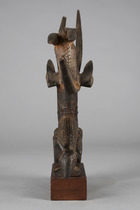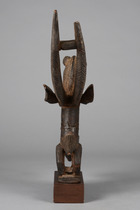Cimier "tijwara", "n'gonzon koun" · Mali, Bamana · ID: 3044687
Vérité Family Collection, Paris, France
Enchères Rive Gauche, Paris, Collection Vérité, 17-18 June 2006, Lot 337
Renaud Vanuxem, Paris, France (2007)
Sotheby’s, Paris, 14 December 2011, Lot 10
Pierre Dartevelle, Brussels, Belgium
Description
wood, metal clamps, base
This headdresses in shape of an antelope, are known as “tijwara” - “the beast who labors” (“tij”: work, “wara”: wild animal). They recall a fabulous being, half man, half animal, who in legendary past thaught man how to cultivate the earth. But as grain grew abundant, men began to waste it. “Tijwara"buried himself in the ground, and men, having lost him, carved a mask in his memory.
These headdresses were in male and female pairs on basketry caps. The dancers were bent over forelegs of wooden sticks, imitating the moves and jums of the antelopes.
The central meaning of the “tijwara” association originally was to encourage cooperation among all members of the community to ensure a successful crop.
Accordingly they performed on three occasions: competitive weeding, dances of joy after the collective field work was done and at the annual celebration of the initiation society.
L’objet Cimier “tijwara”, “n’gonzon koun” numéro d’objet 3044687, a fait partie de la 90.I Tribal Art ainsi que 90.II Contemporary Native American Art du 17 novembre 2018. L’objet portant le numéro de lot 101 a atteint un prix de vente de 9 000 € pour un prix d’adjudication de 8 000 €.
Vous trouverez ici d’autres objets et des informations utiles sur le thème Art africain.
Publications
Goy (Bertrand), "Arts Anciens du Mali", Galerie Renaud Vanuxem, Paris 2007, p. 58 f
AHDRC: 0078297
Exposition
Maison des Arts et Loisirs, "Antilopes chi-wara et portes de sanctuaires africains", Sochaux, 1983






